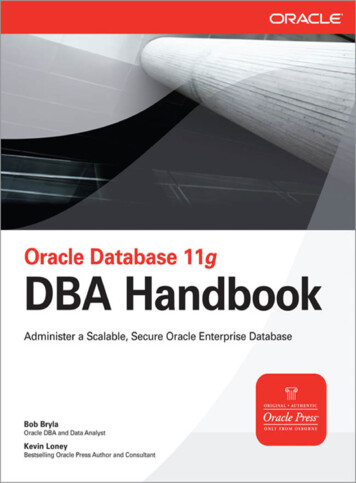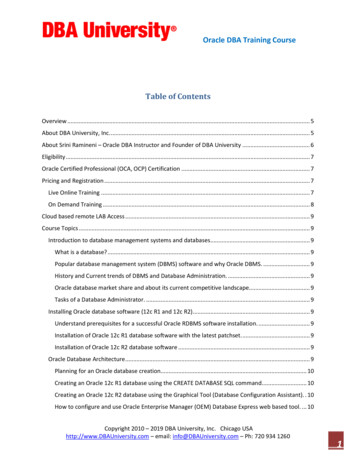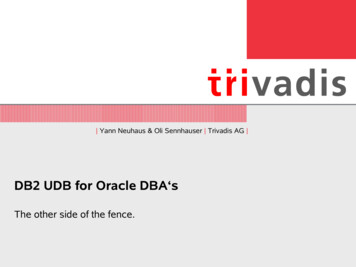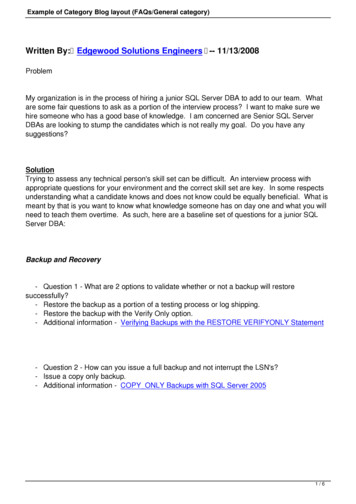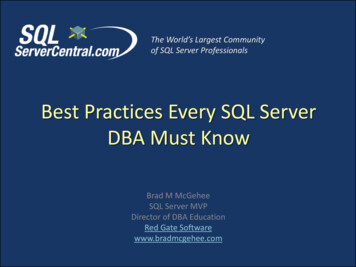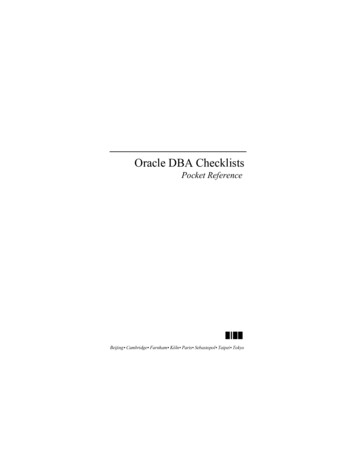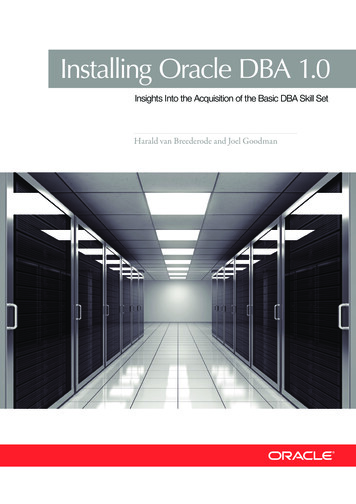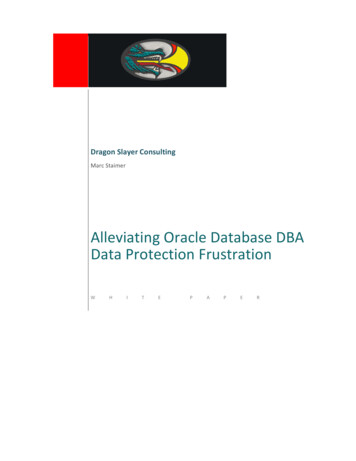
Transcription
Dragon Slayer ConsultingMarc StaimerAlleviating Oracle Database DBAData Protection FrustrationWHITEPAPER
WHITE PAPER Alleviating Oracle Database DBA Data Protection FrustrationAlleviating Oracle Database DBA Data Protection FrustrationMarc Staimer, President of Dragon Slayer ConsultingIntroductionOracle databases are the heart and soul of millions of mission-critical applications worldwide. These areapplications that cannot tolerate much in the way of downtime or lose any data ever. Examples include:e-commerce, financial transactions, ERP, supply chain management, CRM, etc. The databaseadministrators (DBA) know this and take their responsibilities very seriously.Regrettably, the state-of-the-art for Oracle Database protection has been insufficient to meet the DBA’smission-critical requirements. It falls short in many ways, including too much data that can be lost from asystem failure, backups that are too slow, recovery times that are excessively long, crash vs. applicationconsistency, no end-to-end visibility, inability to control the backup/recovery processes (often controlledby storage admins), and more. These challenges have made DBAs increasingly frustrated with the dataprotection “solutions” available--until now.To alleviate this thorny data protection problem for DBAs, Oracle developed Recovery Manager (RMAN).RMAN came out as a built-in utility with Oracle 8 and has been continuously enhanced with each newOracle Database release. RMAN facilitates and simplifies Oracle Database backups, restores, recoveries,disaster recoveries, as well as high availability. It comes with a GUI (graphical user interface), a CLI(command line interface), and an API that enables third-party data protection products to integrate withRMAN. Most of the well-known and many less well renowned data protection products in the marketclaim Oracle RMAN integration.However, integration is not a simple binary process. The level and degree of integration varies byproduct, as does the adherence to Oracle’s SBT API (for integration with RMAN). What a vendor considersas “RMAN integrated,” can certainly fail to meet DBA’s data protection requirements.This paper examines in detail the DBA’s frustrating issues surrounding Oracle Database data protection;why third-party RMAN integration has proven to be limited; and how Oracle is now taking matters into itsown hands with its Zero Data Loss Recovery Appliance (Recovery Appliance).2Dragon Slayer Consulting Q1 2016
WHITE PAPER Alleviating Oracle Database DBA Data Protection FrustrationTable of ContentsIntroduction . 2Fundamental Oracle Database Data Protection Issues. 4 Oracle Recovery Manager (RMAN) Requirement . 4 Where General Purpose Data Protection Solutions Come Up Short . 4 File Backup and Restore . 5 VM Backup and Recovery. 6 VM Replication . 7 Storage Snapshot and Replication. 8 Target Deduplication Storage System with Source-side Deduplication Agents . 9Overview and Review . 10The Oracle Solution: Recovery Appliance . 11Summary. 14For More Information about The Oracle Recovery Appliance . 143Dragon Slayer Consulting Q1 2016
WHITE PAPER Alleviating Oracle Database DBA Data Protection FrustrationFundamental Oracle Database Data Protection IssuesData protection for Oracle Database has always been challenging. As mentioned in the introduction,Oracle databases are at the heart of millions of mission-critical applications. By definition a missioncritical application should always deliver high up-time, minimal outages, and the smallest amount of dataloss in the event of a system failure, human error, human malevolence, site disaster, or natural disaster.Mission-critical application outages incur substantial damage to the organization frequently resulting infar greater financial losses than the cost of mitigating or eliminating those outages. It makes sense thento mitigate or if possible eliminate those potential outages. However, arranging to keep mission-criticalapplications available close to 100% of the time is costly. And most organizations simply do not have thebudgets or people resources required to make it so.That necessitates tradeoffs between mission-critical application uptime vs. data protection cost andgenerally results in the deployment of less than optimal general-purpose data protection systems withthese repercussions: Greater potential for data loss exposure from an outage and missed “recovery point objectives”(RPO) or colloquially known as the time gaps between data protection events; Slow data backup performance—the speed in which data is copied, captured, replicated, andprotected; Slow data recovery—how long does it take to get the mission critical application up, running,online, and accessible typically referred to as “recovery time objective” or RTO; Limited end-to-end visibility as to what data has been protected, where the backups residethroughout their lifecycle, and verification that the backups can indeed be successfullyrecovered. Need for extensive communication, cooperation, and coordination of data protection processesamong the Oracle DBA, data protection or backup administrator; storage administrator, networkadministrator, business continuity/disaster recovery administrator, archive administrator, andincreasingly, the compliance administrator; Much too high total cost of data protection and valued personnel resources.These issues are the ultimate root cause of DBA’s data protection frustration. Here is why. Oracle Recovery Manager (RMAN) RequirementAll Oracle Database data protection efforts must start with RMAN. RMAN is the comprehensive built-innative Oracle Database utility that enables effective online (a.k.a. hot) backup, restores and recovery ofOracle Databases. It takes care of all of the underlying Oracle Database processes to ensure that the datais backed up and recovered in an application consistent manner. RMAN metadata of the backed upOracle Database instance is stored in the control file and optionally (recommended) in the recoverycatalog, which can be browsed and leveraged during restores. Three RMAN crucial efficiency componentsare its block change tracking or BCT (as the name implies BCT tracks and records all Oracle Database fileblock changes enabling backups to simply query the tracking file to incrementally backup the changedblocks versus reading all of the files to locate the changed blocks); block corruption detection in bothbackups and restores; and compression. RMAN management is via Oracle Enterprise Manager or with acommand line interface (CLI). RMAN is table stakes today for Oracle Database data protection. Where General Purpose Data Protection Solutions Come Up ShortThere are many general-purpose data protection solutions.categories:1.2.3.4.5.These solutions generally fall into fiveFile backup and restore;Virtual machine (VM) backup and recovery;VM replication;Storage system snapshot and replication;Target deduplication storage system or source-side deduplication with agent;4Dragon Slayer Consulting Q1 2016
WHITE PAPER Alleviating Oracle Database DBA Data Protection FrustrationEach has significant Oracle Database backup and restore issues that frustrate DBAs. Not all products haveall of the issues discussed. Like all generalizations there are exceptions. File Backup and RestoreFile backup in a general-purpose backup application, is commonly used for backup and restore of theinfrastructure, which includes file system data, applications (e.g. databases) and Virtual Machines inheterogeneous environments. Most commercial file backup products have integrated with Oracle’s SBTAPI to communicate with RMAN. File backup has been traditionally popular because it backs up so manydifferent types of servers, operating systems, file systems, end points, hypervisors, and databases orstructured applications.File backup and restore typically works with Oracle Databaseas follows. An agent (small piece of software) along with theapplication’s SBT Library is installed with each OracleDatabase instance. A media server, which is also known as abackup server, tells the agent to backup the Oracle Databaseinstance if they have embedded RMAN scripts or the DBAmay invoke the backup/restore operation via the RMANinterface. The backup application’s media server then storesthe backup on disk or tape. The media server frequently alsodeduplicates1 and compresses the backups or, depending onthe backup application, deduplication can occur on thedatabase server.This file backup and restore methodology has several severeproblems that truly frustrate DBAs. First and foremost arethe agents. Most backup and restore data protectionsoftware requires an RMAN agent to be co-resident with theOracle Database. Each RMAN agent must be managed justlike any other piece of software. As the backup agents aren'tmanaged by the database or DBA, storage or backup admins must keep the software up-to-date andsynchronized with the latest RMAN releases to be able to take advantage of the RMAN capabilities. And,like any software, it has to be patched, hot-fixed, and upgraded. There is always a time lag, sometimesquite a long time lag, between the latest RMAN release and an updated agent that can optimally utilize it.Agents additionally require system administrative privileges that typically makes many (but not all) ofthem application disruptive. Application disruptive agents require a system reboot for installation,patches, hot-fixes, and upgrades. Mission critical applications (and when are Oracle Databaseapplications not mission critical?) do not handle downtime disruptions well. Those downtime disruptionsmust be scheduled, usually on a weekend. And, when the RMAN agents are performing their backups,they seize and consume precious CPU, memory, and IO resources that become unavailable to the OracleDatabase and impact performance.Another non-trivial issue with those agents is when the Oracle Database is running on Exadata, Exalytics,or SuperCluster Engineered Systems. Oracle allows those third party RMAN agents to be implementedand run on the Engineered Systems although with restrictions. When it comes to the media serversoftware, Oracle explicitly does not support it and that software cannot use Engineered Systems storageas a target. This means when there are issues with the backup and restore software or third-party RMANagents (and there are always issues), the responsibility for fixing them belongs to the software supplierand customer, not Oracle.File backup and restore are moreover hampered by a severely limited recovery point objective (RPO). TheRPO is the length of time since the last backup, which can be hours, or more likely, a full day. That issimply too long for those mission-critical applications based on the Oracle Database. Long RPOs can1Deduplication technologies provide limited results when utilized with Oracle Databases because the majority of Oracle Databaseheaders are unique.5Dragon Slayer Consulting Q1 2016
WHITE PAPER Alleviating Oracle Database DBA Data Protection Frustrationprolong an Oracle Database recovery by several hours. This is because the DBA has to recreate themissing gap in the backed up data. Recreating that missing data is non-trivial requiring extensive andarduous manually labor-intensive tasks.Backups are multiple processes that require a great deal of time. Backup administrators following bestpractices historically run full Oracle Database backups once a week, incremental backups daily, andarchived log backup periodically throughout the day. Each backup set is deduplicated and compressedbefore being written to disk assuming inline deduplication thereby adding time to the backup. While theycan achieve some level of deduplication for a full backup, incremental backup deduplication ratios wouldbe minimal, if any, and no deduplication can be achieved for archived log backups. In an attempt make upfor slow individual Oracle Database backups, the media server will try to backup multiple Oracle Databaseinstances (each with its own agent) in parallel. That doesn’t speed up the backups of each individualOracle Database and often slows each down somewhat; however, the backup performance in aggregate isfaster. But, when those Oracle Database instances run on the same physical host in virtual machines(VMs) or containers, backup performance plummets. Each backup draws on the same host resources(CPU, memory, IO) in the same timeframe slowing completion of each backup so significantly that theycan and do fail. Longer, not shorter, backup windows and greater probabilities of backup failures is notwhat DBAs are seeking.Retention management is yet another problem Oracle DBAs continually run into. When the retention isset and managed by the backup software, the DBA shouldn’t have to worry about retention. But they dobecause the backup software will delete backups when they have reached the end of their retentionperiod without any consideration for Oracle Database recoverability.Restoring Oracle Databases from file
To alleviate this thorny data protection problem for DBAs, Oracle developed Recovery Manager(RMAN). RMAN came out as a built-in utility with Oracle 8 and has been continuously enhanced with each new Oracle Database release. RMAN facilitates and simplifies Oracle Database backups, restores, recoveries, disaster recoveries, as well as high availability. It comes with a GUI (graphical user interface), a CLI

